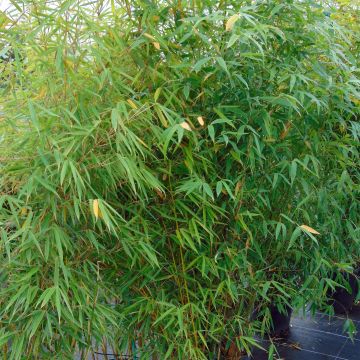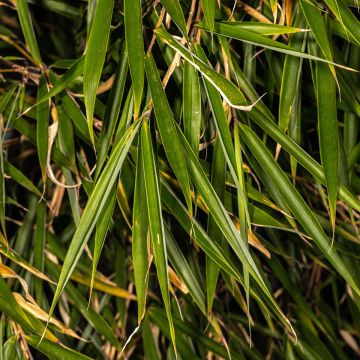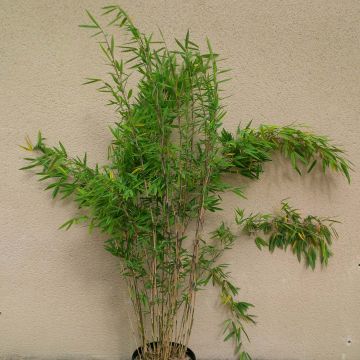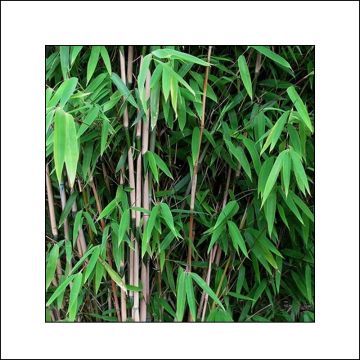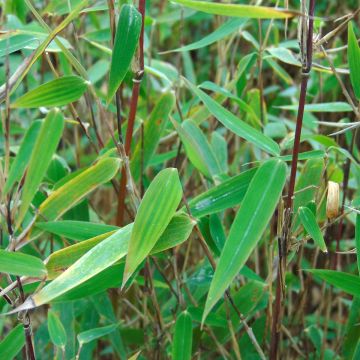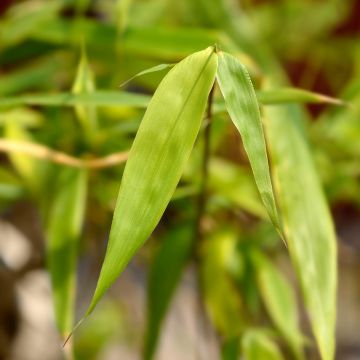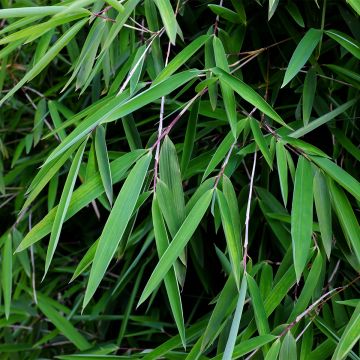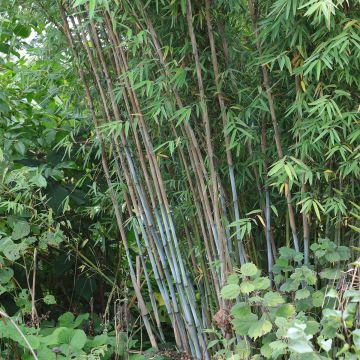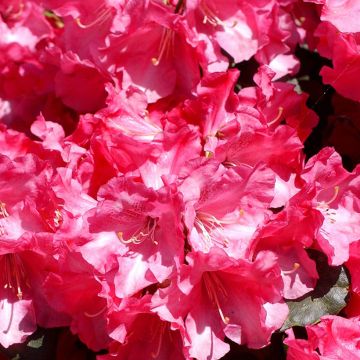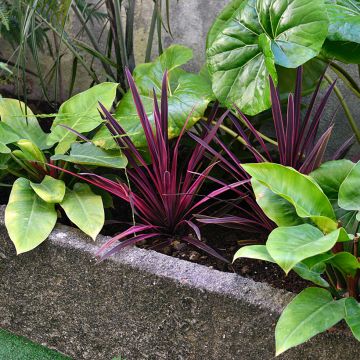

Fargesia murieliae Elias - Bambou nain non traçant


Fargesia murieliae Elias - Bambou nain non traçant
Fargesia murielae Elias
Fargesia murielae Elias
Fountain Bamboo, Umbrella Bamboo
Why not try an alternative variety in stock?
View all →This plant carries a 24 months recovery warranty
More information
We guarantee the quality of our plants for a full growing cycle, and will replace at our expense any plant that fails to recover under normal climatic and planting conditions.
From €5.90 for pickup delivery and €6.90 for home delivery
Express home delivery from €8.90.
Does this plant fit my garden?
Set up your Plantfit profile →
Description
The Fargesia murielae 'Elias' is a variety of non-invasive bamboo of small size and well bushy, capable of maintaining for years its appearance of a friendly and endearing bush. Covered with long, evergreen leaves of shiny green that cascade down its rounded profile, it is decorative all year round. This miniature umbrella bamboo slowly spreads over the years, without ever becoming invasive. 'Elias' is therefore particularly suitable for ornamenting small spaces, both in the ground and in pots. Very resistant to cold, it prefers partial shade and well-drained, fresh, non-chalky soils.
The Fargesia murielae is a plant of the family Poaceae, a kind of grass with woody stems that develops from a non-invasive rhizomatous base, known as a clump-forming bamboo. In this type of bamboo, the very short internode rhizomes slowly develop at the periphery of the stump, which gradually widens, but they also develop towards the centre of the clump, which remains very dense without thinning out in the middle. The umbrella bamboo, also known as Sinarundinaria murielae, is native to the mountains in central China and is one of the hardiest bamboos. It has survived in Eastern European countries with very harsh winters.
The cultivar 'Elias', recently selected in Germany, won a gold medal at the GrootGroenPlus trade fair (Netherlands) in 2017. It is a form similar to the variety 'Luca'; both are the most compact forms of Fargesia murielae currently available. 'Elias' slowly forms a spreading and dense clump that will reach approximately 60cm (23.6 in) in height and 70cm (27.6 in) in width. Eventually, the plant will spread over 1m (3 ft 4 in) on the ground. The canes or culms are very short, erect, slender, 1cm (0.4 in) in diameter but sturdy, almost invisible under the foliage. The foliage, present on the culms, is evergreen and distributed throughout their height. Abundant, the leaves are narrower and elongated than those of other varieties. They are lanceolate and tapering at their tips, with a glossy dark green colour.
The compact Fargesia murielae Elias will make a big impact in a standalone bush or integrated into a low shrub border, or even in a large pot or container on a balcony or terrace. To brighten its foliage in summer, it can be planted with a bushy herbaceous clematis of the integrifolia type, with blue bells, very natural-looking, a dwarf sacred bamboo (Nandina Obsessed Seika), a small Mexican orange Apple Blossom. 'Elias' is ideal for a partially shaded path, and of course in a Japanese garden, with pieris and Japanese azaleas.
Report an error about the product description
Fargesia murielae Elias in pictures




Plant habit
Foliage
Botanical data
Fargesia
murielae
Elias
Poaceae
Fountain Bamboo, Umbrella Bamboo
Cultivar or hybrid
Other Non-spreading Bamboos
Planting and care
The Fargesia murielae Elias does well in partially or fully shaded areas, especially in warm climates. It's sensitive to too much sun and drought, so keeping it in a shady position and well-watered is essential. When planting, choose moist, rich soil, and avoid limestone. It's best to plant in the spring or autumn in mild climates and leave enough space to grow over time, as it can spread up to 10 metres (32 feet 10 inches). The mature plant requires about 20 litres of water per week during hot periods and 10 litres for the rest of the year. If you choose to plant it in a pot, monitor watering carefully and add two handfuls of fertiliser at the base of the bamboo from early March to mid-April. This will help keep its foliage green. Be aware that slugs can eat young shoots. Unlike other Fargesia types, this non-invasive bamboo doesn't require a rhizome barrier when planting. It retains its green foliage in winter but may lose some leaves depending on the temperature throughout the year.
Planting period
Intended location
Care
This item has not been reviewed yet - be the first to leave a review about it.
Evergreen shrubs
Haven't found what you were looking for?
Hardiness is the lowest winter temperature a plant can endure without suffering serious damage or even dying. However, hardiness is affected by location (a sheltered area, such as a patio), protection (winter cover) and soil type (hardiness is improved by well-drained soil).

Photo Sharing Terms & Conditions
In order to encourage gardeners to interact and share their experiences, Promesse de fleurs offers various media enabling content to be uploaded onto its Site - in particular via the ‘Photo sharing’ module.
The User agrees to refrain from:
- Posting any content that is illegal, prejudicial, insulting, racist, inciteful to hatred, revisionist, contrary to public decency, that infringes on privacy or on the privacy rights of third parties, in particular the publicity rights of persons and goods, intellectual property rights, or the right to privacy.
- Submitting content on behalf of a third party;
- Impersonate the identity of a third party and/or publish any personal information about a third party;
In general, the User undertakes to refrain from any unethical behaviour.
All Content (in particular text, comments, files, images, photos, videos, creative works, etc.), which may be subject to property or intellectual property rights, image or other private rights, shall remain the property of the User, subject to the limited rights granted by the terms of the licence granted by Promesse de fleurs as stated below. Users are at liberty to publish or not to publish such Content on the Site, notably via the ‘Photo Sharing’ facility, and accept that this Content shall be made public and freely accessible, notably on the Internet.
Users further acknowledge, undertake to have ,and guarantee that they hold all necessary rights and permissions to publish such material on the Site, in particular with regard to the legislation in force pertaining to any privacy, property, intellectual property, image, or contractual rights, or rights of any other nature. By publishing such Content on the Site, Users acknowledge accepting full liability as publishers of the Content within the meaning of the law, and grant Promesse de fleurs, free of charge, an inclusive, worldwide licence for the said Content for the entire duration of its publication, including all reproduction, representation, up/downloading, displaying, performing, transmission, and storage rights.
Users also grant permission for their name to be linked to the Content and accept that this link may not always be made available.
By engaging in posting material, Users consent to their Content becoming automatically accessible on the Internet, in particular on other sites and/or blogs and/or web pages of the Promesse de fleurs site, including in particular social pages and the Promesse de fleurs catalogue.
Users may secure the removal of entrusted content free of charge by issuing a simple request via our contact form.
The flowering period indicated on our website applies to countries and regions located in USDA zone 8 (France, the United Kingdom, Ireland, the Netherlands, etc.)
It will vary according to where you live:
- In zones 9 to 10 (Italy, Spain, Greece, etc.), flowering will occur about 2 to 4 weeks earlier.
- In zones 6 to 7 (Germany, Poland, Slovenia, and lower mountainous regions), flowering will be delayed by 2 to 3 weeks.
- In zone 5 (Central Europe, Scandinavia), blooming will be delayed by 3 to 5 weeks.
In temperate climates, pruning of spring-flowering shrubs (forsythia, spireas, etc.) should be done just after flowering.
Pruning of summer-flowering shrubs (Indian Lilac, Perovskia, etc.) can be done in winter or spring.
In cold regions as well as with frost-sensitive plants, avoid pruning too early when severe frosts may still occur.
The planting period indicated on our website applies to countries and regions located in USDA zone 8 (France, United Kingdom, Ireland, Netherlands).
It will vary according to where you live:
- In Mediterranean zones (Marseille, Madrid, Milan, etc.), autumn and winter are the best planting periods.
- In continental zones (Strasbourg, Munich, Vienna, etc.), delay planting by 2 to 3 weeks in spring and bring it forward by 2 to 4 weeks in autumn.
- In mountainous regions (the Alps, Pyrenees, Carpathians, etc.), it is best to plant in late spring (May-June) or late summer (August-September).
The harvesting period indicated on our website applies to countries and regions in USDA zone 8 (France, England, Ireland, the Netherlands).
In colder areas (Scandinavia, Poland, Austria...) fruit and vegetable harvests are likely to be delayed by 3-4 weeks.
In warmer areas (Italy, Spain, Greece, etc.), harvesting will probably take place earlier, depending on weather conditions.
The sowing periods indicated on our website apply to countries and regions within USDA Zone 8 (France, UK, Ireland, Netherlands).
In colder areas (Scandinavia, Poland, Austria...), delay any outdoor sowing by 3-4 weeks, or sow under glass.
In warmer climes (Italy, Spain, Greece, etc.), bring outdoor sowing forward by a few weeks.

































